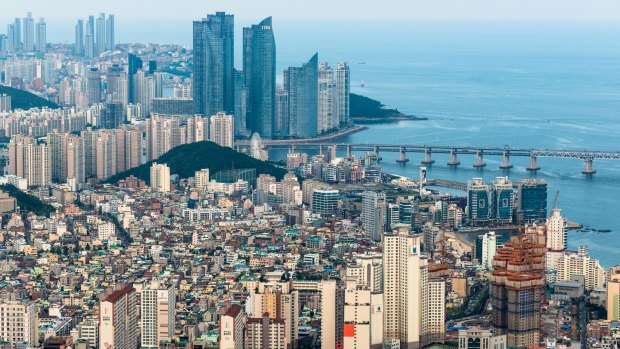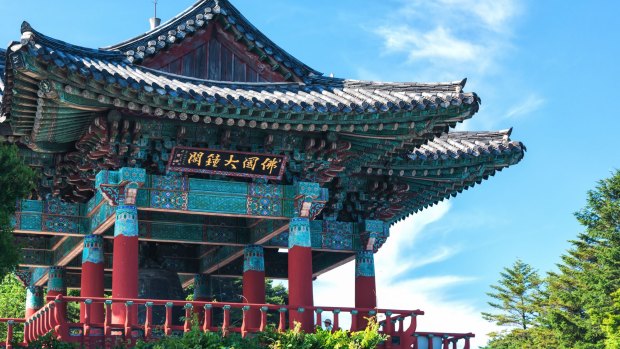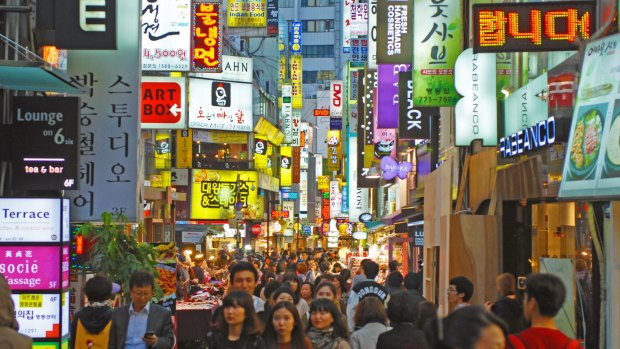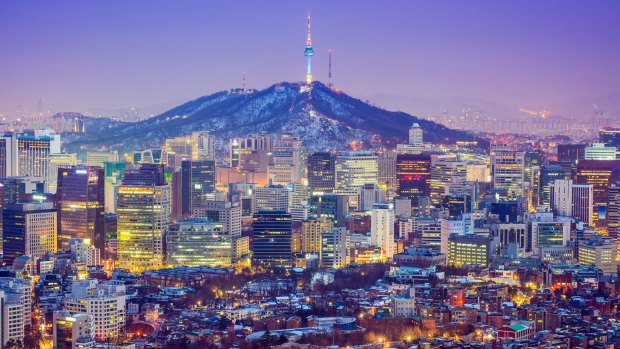This was published 6 years ago
South Korea: The Winter Olympics and five other reasons why now is the time to visit

Busan skyline in Yeongnam province.Credit: Alamy
You could be excused for not knowing a whole lot about the Republic of Korea. This is, after all, a country that only rarely features in the news, a peaceful, safe place that is often overshadowed in the global consciousness by the "rocket man" to its north.
And even when you do hear about it, South Korea is a nation and a culture that can appear a little opaque. Its language is an impenetrable jungle of consonants and vowels. Its celebrities are K-pop stars and native-language actors whose fame rarely translates into the West. Its cuisine is little known beyond cook-your-own barbecues and fried chicken.
So yes, you could be excused for not knowing a whole lot about South Korea. That is, until now. Because in a few short weeks, the 23rd Winter Olympics will kick off in Pyeongchang, a mountainous region in the north-east of the nation, and it marks the perfect time for South Korea to show off so much of what makes it great.

Traditional Korean architecture at Seokguram Grotto in Gyeongju, South Korea. Credit: Alamy
And there's a lot. I've learned a huge amount about this country since I first visited in 2008. I've enjoyed discovering its quirks and eccentricities, its deep and ancient traditions and its obsession with ultra-modernity.
I've found that this isn't just a winter destination, though the ski slopes will obviously feature heavily in coverage of the Games. South Korea is a great place to visit year-round, with everything from high mountain peaks to sandy beaches, quiet rural villages to booming metropolises. A holiday here can be just about anything you want it to be, from bathhouse visits to temple stays; rowdy nights out to time for spiritual reflection.
There's much to love about this country. And now is the time to discover it.

Shoppers and nightlife on the streets of Myeongdong, Seoul.Credit: Alamy
THE COOL CAPITAL: SEOUL
WHERE IS IT The north-east, in the Seoul Capital Area.
WHY WE LOVE IT South Korea's capital is a multifaceted boom town, a 24-hour metropolis where there's always something to see, something to do and something to eat.

Seoul skyline at twilight.Credit: Alamy
DON'T MISS This city of 10 million people is best tackled as a series of neighbourhoods, each with its own atmosphere and attractions. The Jongno district is Seoul's historic heart, where you'll find heritage-listed palaces such as Gyeongbokgung and Changdeokgung. Elsewhere, Myeongdong is known for its upmarket shopping, Hongdae and Itaewon are bustling nightlife hubs, and Gangnam is modern and stylish.
STAYING THERE Seoul's Park Hyatt Hotel oozes modern class, a five-star property with rooms that look like they're straight out of a high-end Danish design catalogue. See park.hyatt.com
ESSENTIALS Seoul is a year-round destination, though it's most comfortable from March to May, and September to November. There are no major issues with security or health.
THE WINTER GAMES HOST: PYEONGCHANG
WHERE IS IT The north-western Gangwon province.
WHY WE LOVE IT The host city of the 2018 Games is a friendly mountain town that's appealing both in the cooler months for its snow sports, and in summer for its wildflower-lined hiking paths.
DON'T MISS The highlight of Pyeongchang's 2018 calendar occurs next month, when sports fans arrive with their giant cowbells to cheer on the Olympic athletes. However, even if you don't make the Games, there's plenty to enjoy in Pyeongchang, from skiing and snowboarding at Alpensia Resort or Dragon Valley, to the vast array of alpine hiking trails in Odaesan National Park, plus museums, cultural villages, and the chance to sample the area's famed soju.
STAYING THERE The accommodation at Alpensia Ski Resort provides easy access for Olympic viewers, as well as those who'd just like to enjoy the area. See aplensiaresort.co.kr
ESSENTIALS The South Korean ski season runs from December to March, though many resorts will be closed during the Games. The train and bus ride from Seoul to Pyeongchang takes about three hours.
THE FOODIE MECCA: JEONJU
WHERE IS IT The country's central west, in North Jeolla province.
WHY WE LOVE IT In a word: food. If Seoul is South Korea's beating heart, then Jeonju is its growling stomach. People flock from around the country just to eat.
DON'T MISS The most popular of Jeonju's physical attractions is the Hanok Village, a series of traditional homes, or "hanoks", that date back hundreds of years – many offer basic accommodation. However, what people are really here for is the food. Jeonju is the home of bibimbap, the mix of rice, egg, meat, vegetables and kimchi that's ubiquitous country-wide, as well as kongnamul gukbap, a delicious soup made from fresh bean sprouts, topped with rice.
STAYING THERE Any of the homestays within the Hanok Village will provide a memorable night. See visitkorea.org.au for information on how to book.
ESSENTIALS Jeonju is popular year-round, though will be very busy during South Korean holidays. The city is a one-hour and 40-minute train ride from Seoul.
THE SECOND CITY: BUSAN
WHERE IS IT On the south-eastern coast, in the Yeongnam region.
WHY WE LOVE IT Busan is a multisensory joy, from the sight of beaches and mountains, to the taste of fresh seafood, to the rollicking atmosphere of a busy port town that has morphed into a hipster enclave.
DON'T MISS Your first port of call is Jagalchi Fish Market, a sprawling dockside arcade in which you'll find pretty much every tasty seafood treat imaginable, and possibly some that aren't. Choose the produce you like, then have it cooked by one of the restaurants above the market. Busan is also home to one of South Korea's best night markets, Bupyeong, as well as a burgeoning craft beer scene: check out Galmegi Brewing for great alternatives to South Korea's samey commercial beers.
STAYING THERE The Paradise Hotel Busan is modern and stylish, and near Haeundae Beach, as well as public transport. See lhw.com
ESSENTIALS Busan is most popular in summer, though if you're prepared to forgo time in the sun, spring and autumn are less crowded and pleasant. Express trains from Seoul to Busan take about three hours.
THE FORMER CAPITAL: GYEONGJU
WHERE IS IT On the south-eastern coast, in the North Gyeongsang province.
WHY WE LOVE IT Gyeongju's history stretches back thousands of years – this was the prosperous capital of the ancient Silla kingdom, and much of that former glory remains in this easily manageable city.
DON'T MISS If you're here for the history, begin in Bulguksa, one of South Korea's most famous temples, and one with a spectacular backdrop of mountain scenery. From there, move on to Seokguram, a UNESCO-listed grotto in the mountains, featuring a carving of the Buddha, before perusing the Gyeongju National Museum and the Royal Tombs back in the city itself.
STAYING THERE For something a little different (and active), spend a few nights at the Golgulsa Temple. This is a working Buddhist monastery at which you'll be expected to participate in meditation rituals, as well as twice-daily martial arts classes. See eng.templestay.com
ESSENTIALS Gyeongju is popular year-round. To get there, take the two-hour express train from Seoul.
THE ART AND DESIGN HUB: GWANGJU
WHERE IS IT In the south-west, in the Honam region.
WHY WE LOVE IT Though there's plenty of history in Gwangju, South Korea's sixth largest city, it's the modern culture that draws most visitors, with a thriving art and design scene.
DON'T MISS There's plenty on offer for those keen to sample Gwangju's art scene. The appropriately titled "Art Street" is a three-block strip of galleries and shop fronts in the Dong-gu district, most featuring works by local artists. Every Saturday night, meanwhile, the Daein Market provides another outlet for artisans and craftsmen to peddle their wares. Elsewhere, Yangdong Market in the Seo-gu district has clothing by local designers, while the 1913 Songjeong Station Market has the city's best street food.
STAYING THERE Soak up Gwangju's history with a few nights in a traditional hanok house – Misori Guesthouse is one of the most popular. See sg.hotels.com
ESSENTIALS It's possible to visit Gwangju year-round, though it's cold in winter and can be humid in summer. The city is a two-hour train ride from Seoul.
THE BEAUTY SPOT: JEJU ISLAND
WHERE IS IT Off the south coast.
WHY WE LOVE IT This is probably not the South Korea you're picturing: Jeju Island is something of a tropical paradise, with beaches, lush forest, volcanic outcrops, and plenty of domestic holidaymakers enjoying it all.
DON'T MISS A little time in the sun. A stay in Jeju can be as active or as sedentary as you desire, though whatever you do, it will probably be outdoors. Go hiking in Hallasan National Park, stroll through the Jeju April 3 Peace Park, explore the world's longest system to lava tube caves in Manjanggul, go scuba diving in the warm ocean or simply relax at one of the many beach resorts.
STAYING THERE The Shilla Jeju is regarded as the island's best hotel, a sprawling five-star property with private gardens and access to many of Jeju's attractions. See shillahotels.com
ESSENTIALS Though there are ferries from mainland South Korea to Jeju, the easiest way to reach the island is by plane from Seoul. There are also direct flights from Japan and China. Jeju is best from May to September. See visitkorea.org.au
THE DEEP DIVIDE: THE DMZ
WHERE IS IT The border between South Korea and North Korea.
WHY WE LOVE IT The Korean Demilitarised Zone may seem an odd place to spend part of your holiday; however, to visit this most famous of borders is to witness the deep divide between the two parts of what was once a single entity.
DON'T MISS The most popular visitation point in the DMZ is Panmunjom, a Cold War-era village where a truce was signed at the end of the Korean War, and where soldiers from either side of the fence still glare at one another with almost comical ferocity as tensions simmer. Foreigners are allowed to visit Panmunjom as part of organised day tours from Seoul; once in Panmunjom you'll have the chance to officially step into North Korea in a conference hut that straddles the demarcation line, as well as visit one of four tunnels that were secretly dug by the North Koreans.
STAYING THERE There's no place for the public to stay in the DMZ. For day tours from Seoul, see panmunjomtour.com or uso.org/korea
ESSENTIALS Though the DMZ is open to the public, you'll need to apply for your place on a tour at least three days in advance, and the area can be closed at short notice.
TRIP NOTES
MORE
FLY
Korean Air and Asiana (which codeshares with Qantas) fly direct from the east coast capitals of Australia to Seoul-Incheon, while many Japanese, Chinese and even Malaysian carriers can get you there with a brief stopover. Australian travellers can enter South Korea without a visa for up to 90 days.
SPEND
The currency is the "won" – at the time of writing, one Australian dollar was buying 832 won. Credit card payment is widely accepted in Korea.
SPEAK
Most signage in South Korea, particularly in the big cities, is in Korean and English. Plenty of younger Koreans also speak excellent English, though in rural areas it will help to at least speak a few words of the local language.
RIDE
South Korea has efficient and affordable public transport, from the metro systems in Seoul, Busan, Daegu and Gwangju, to nationwide train and bus services. See visitkorea.org.au
EAT
As much as you can. Korean food is delicious, and much loved by locals. From the cheapest "chimaek", or fried chicken and beer joint, to the most expensive traditional restaurant, you'll find food is fresh, spicy, flavoursome, relatively healthy, and available pretty much any hour of the day. (See panel for some of our favourite dishes.)
DRINK
Beer is generally the drink of choice for Koreans, though the rice spirit, soju, is also popular, as is makgeolli, a fermented rice beer. For something a little softer, try Korean tea, or banana-flavoured milk.
PREVENT
South Korea is a safe destination with a low crime rate, and no special vaccinations are required. For the latest travel, health and safety information, see smartraveller.gov.au
NORTH OF THE BORDER: TO VISITOR NOT TO VISIT
There are two big, important questions to consider when it comes to a trip to South Korea's notoriously tetchy northern neighbour, the Democratic People's Republic of Korea: can you travel there; and should you travel there?
The first is the simplest to answer. Yes, Australian citizens can travel to North Korea. You'll have to apply for a visa and book your travel through an approved tour company, but it is possible. The Australian government's Smart Traveller website currently warns Australians to "Reconsider your need to travel" to the DPRK; however, at that level most travel insurance policies will cover you (though, as ever, check the wording of yours closely, and monitor smartraveller.gov.au for updates).
The second question is a little trickier. There are things to see in North Korea, and experiences to be had. However, this is a country ruled by a brutal regime, a regime that will reap the benefit, financially at least, from your decision to visit.
If you make the call, however, that travel boycotts simply harm the wrong people, and that you'd like to see this place, then North Korea is a genuine option – there's nowhere in the world quite like this. Be warned though: once there, you'll be expected to follow North Korean customs, and show respect to North Korean leaders. You'll also have a government chaperone for your entire trip.
There are no Australian-based tour companies running trips to North Korea – Intrepid Travel has put its expedition-style tours to the country on hold due to lack of interest – so you'll need to go with a company such as China-based Koryo Tours. See koryogroup.com
FIVE UNIQUE KOREAN CULTURAL QUIRKS: A SPOTTER'S GUIDE
K-POP
Korean pop music isn't just a genre, it's an obsession. It's an all-singing, all-dancing and all-smiling mix of cutesy schmaltz and dancefloor-filling hype, popularised worldwide by a guy called Psy, with a little song called Gangnam Style. Get to a concert for the full experience.
FASHION VICTIMS
South Koreans take their fashion seriously – sometimes too seriously. Keep an eye out for sartorial quirks such as "couple dressing" (when two people in a relationship hit the town wearing exactly the same clothes), the obsession with high-end, matching leisurewear and the women's amazing ability to do almost anything while wearing high heels.
NORAEBANG
Any boozy night out with a group of Koreans will inevitably involve a trip to a "noraebang", or karaoke room. South Koreans love to sing, and will often compensate for a lack of talent with their enthusiasm. Prepare yourself for a long night of songs you've never heard before.
HAND STEAK
Ever wanted to eat a steak and drink a beer while walking around a park at the same time? No, thought not. Apparently though, South Koreans enjoy this, which is why the "hand steak" is a thing: picture a large cup of beer with a smaller cup of steak and chips resting on top of it, complete with a straw and a fork, and you're getting the idea.
JIMJILBANG
A "jimjilbang", or Korean bathhouse, is a city unto itself, a sprawling complex that will likely feature not just hot baths and saunas, but a barber, a bar, restaurants, karaoke rooms and even a cinema. A trip to a jimjilbang is a must for those seeking a true Korean experience.
FIVE MUST-TRY CLASSIC DISHES IN KOREA
FRIED CHICKEN
Thanks to the influx of American soldiers since the war, South Koreans have an unhealthy appreciation for fried chicken, and they do it even better than the Colonel. Make sure you check out a "chimaek", a restaurant that specialises in spicy fried chicken and beer.
BARBECUE
You'll be able to spot these restaurants by the telltale exhaust fans hanging over every table. Cuts of meat such as pork belly, tongue, and South Korean wagyu beef are grilled over charcoal and eaten with lettuce leaves, fresh garlic, and a fermented chilli sauce called gochujang.
KONGNAMUL GUKBAP
This soup, a specialty of Jeonju, is the breakfast of champions: a rich stock made with fresh, aromatic bean sprouts is topped up with rice, before being devoured as a recovery from the alcoholic excesses of the night before.
BINDAETTEOK
Mung beans are soaked in water then ground to a paste to make the base for these delicious fried pancakes, which usually have kimchi and beef, and even hunks of crispy pork belly added before they're shallow-fried.
BIBIMBAP
You haven't been to South Korea until you've eaten bibimbap. Hot, fluffy rice is topped with meat, bean sprouts, pickles, kimchi, a raw egg and a dollop of gochujang before it's all mixed together in a hot earthenware pot and attacked with gusto.
FIVE NATURAL ATTRACTIONS WORTH A VISIT
SEONGSAN ILCHULBONG
On tropical Jeju Island, Seongsan Ilchulbong is a UNESCO World Heritage site, a stunning mountain peak that's accessible via a gentle 30-minute hike. At the top you'll find a 5000-year-old volcanic crater lined with rocky spires that resemble a crown.
SEORAKSAN MOUNTAIN
The tallest peak in the Taebaek mountain range in eastern South Korea is a spectacular sight, particularly in autumn when the leaves are a riot of reds and yellows. Add mountain streams, rocky outcrops and hanging mist, and you're beginning to understand the area's beauty.
BULGUKSA TEMPLE
This is one of South Korea's most famous historic sites, a temple flanked by two granite pagodas, set among lush forest in the mountains in the south. Bulguksa houses several national treasures, and is understandably popular.
BOSEONG TEA FIELD
Bring the camera on your trip to Boseong, a tea plantation set among cedar forests in the far south. Here, five hiking courses will lead you on a full tour of the manicured gardens, via observatories and rest centres.
SERYANG-JE
This man-made reservoir in the nation's south-west is extremely popular among landscape photographers, who come to capture the area's blossoms and leaves as they're reflected in the perfectly still water of the lake.
Sign up for the Traveller Deals newsletter
Get exclusive travel deals delivered straight to your inbox. Sign up now.